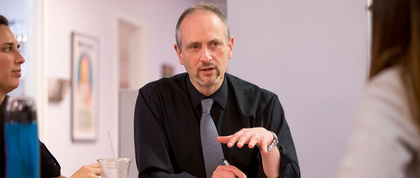
Dr. David Abramson, a man whose efforts in disaster science have not gone unnoticed, received the American College of Epidemiology’s Translation of Disaster Epidemiology Into Public Health Award on September 26th.
Dr. Abramson’s path to disaster science began with journalism. Throughout his 20s, as a magazine writer working for such publications as Rolling Stone, Outside, and Esquire, he spent his time traveling around the country in search of stories. The core of this “long-form journalism” involved people’s stories that reflected larger social issues. He wrote about the environmental and social degradation of a Northern California lumber town as its virgin redwoods were clear-cut for profits; reclamation efforts in the South Bronx spurred by entrepreneurialism and community development; and the murder rate among innocent young people caught in the cross-fire of drug wars in Oakland, among other stories. In each of these stories, large social forces shaped people’s lives, and often constrained their choices.
As a counter-balance to his writing, Dr. Abramson also volunteered in a rural upstate community as a paramedic and emergency medical services planner. The emergency work was all about direct action, in contrast to the more analytic reflection on social issues in his journalism. It was this life chapter that foreshadowed his next steps into public health through his combined journalistic curiosity and his desire as an EMS provider to help those in need. He elected to pursue first an MPH, and subsequently a doctorate in public health and political science, at Columbia University.
His impulse to “go out and do something” drove Dr. Abramson into HIV/AIDs research studies beginning in 1991. He began as a graduate student and ended up as Co-Investigator of a longitudinal HIV cohort study in the greater New York City area. When Hurricane Katrina struck the Gulf Coast in 2005 he took his HIV study team and a group of 30 graduate students in to the field with him to launch the Gulf Coast Child and Family Health Study, a longitudinal disaster study. The team traveled to trailer parks, hotels, and impacted communities throughout Louisiana and Mississippi to conduct over 1,000 surveys with affected families and individuals. For 5 years he continued to follow up on how each family was doing, with a particular focus on children. The study was the first of what would become an expanding portfolio of disaster research. Katrina led to the Deepwater Horizon oil spill, the Joplin tornado, H1N1, Superstorm Sandy, and Zika, among other natural and man-made hazards that he has studied.
Dr. Abramson’s study on the Deepwater Horizon oil spill focused on the toll that the accident took on young people. A number of children along the affected areas of the Gulf Coast had direct exposure to the environmental toxins of the oil and dispersants as well as to the economic effects of the seafood and oil exploration industries. Latch-key kidswere left to care for younger children as distraught parents struggled to find a way to provide for their family, and risk behaviors among both youth and adults skyrocketed. Dr. Abramson found that kids wanted to make a difference in their community for the better. With the help of a colleague, he co-founded “SHOREline,” an academic project-based learning program that strove to cultivate Skills, Hope, Opportunity, and Resilience through Engagement, among its high school participants. What began as a youth empowerment project in a number of Gulf Coast high schools expanded to several New York City public high schools as well. Given its focus on promoting pro-social behaviors teenagers, the project’s primary mission is “youth helping youth recover from disasters.”
Recovery and resilience have become the enduring themes of Dr. Abramson’s work. With funding from NIH, he has extended his Katrina study to be one of the longest-running population studies of disaster recovery. As he is quick to note, “the true work that takes a lot of time is recovery. Disaster response is dramatic, and often gets most of the attention, but in fact the large majority of a disaster’s expense – around 80% -- is in the cost of recovery” Sustainability is found in the recovery of a community rebuilding its structure, and of individuals regaining, or improving, their social position.
In 2014, Dr. Abramson brought his research program to NYU’s College of Global Public Health , where he is a Clinical Associate Professorand as director of the Population Impact, Recovery, and Resilience Lab, PiR2. His lab focuses on applying social science theory and methodology to the study of disaster effects on vulnerable populations, and to developing an understanding of resilience and long-term disaster recovery. Dr. Abramson teaches a number of these concepts in two GPH courses – “Public Health Emergency Preparedness and Response – A Global Perspective,” a study-abroad class which has studied in Israel and Cuba; and “Disasters, Complex Systems, and the Social Ecology of Health.”
Dr. Abramson was recently a featured guest on the first episode of 5% and Falling, a new podcast from NYU GPH, in which he talked about his studies and about resilience. The podcast is available on iTunes, Stitcher Radio, and Google Play.
For more information on Dr. Abramson please visit his faculty profile. If interested in applying for the lab, he encourages you to send him your CV and a brief letter describing your interest.